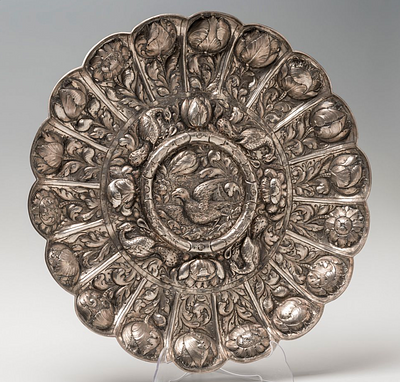Hispanic-Filipino Christ of the XVII century. Carved and polychrome wood. Silver trimmings.
Lot 93
About Seller
Setdart Auction House
Carrer Aragó 346
Barcelona
Spain
Setdart Subastas was born in 2004 and is currently the first online art auction in Spain with solidity, prestige and reliability guaranteed by our more than 60,000 users. Setdart has a young, dynamic and enterprising team ready to successfully manage the purchase and sale of art works through custom...Read more
Categories
Estimate:
EUR€7,000 - EUR€8,000
$7,368.42 - $8,421.05
Absentee vs Live bid
Two ways to bid:
- Leave a max absentee bid and the platform will bid on your behalf up to your maximum bid during the live auction.
- Bid live during the auction and your bids will be submitted real-time to the auctioneer.
Bid Increments
| Price | Bid Increment |
|---|---|
| EUR€0 | EUR€10 |
| EUR€200 | EUR€25 |
| EUR€500 | EUR€50 |
| EUR€1,000 | EUR€100 |
| EUR€3,000 | EUR€200 |
| EUR€5,000 | EUR€500 |
| EUR€10,000 | EUR€1,000 |
| EUR€20,000 | EUR€2,000 |
| EUR€50,000 | EUR€5,000 |
About Auction
By Setdart Auction House
Jul 13, 2021
Set Reminder
2021-07-13 07:00:00
2021-07-13 07:00:00
America/New_York
Bidsquare
Bidsquare : DECORATIVE ARTS XV-XIX
https://www.bidsquare.com/auctions/setdart-auction-house/decorative-arts-xv-xix-7201
Setdart Auction House sofia@setdart.com
Setdart Auction House sofia@setdart.com
- Lot Description
Hispanic-Filipino Christ of the XVII century. Carved and polychrome wood. Silver trimmings. Measures: 66 x 53 cm (Christ); 118 x 82 cm (cross). Christ of three nails, in carved and polychrome wood. It is an image of Christ expiring, so that the pathos is enhanced by the half-open mouth, arched eyebrows and imploring eyes looking at the sky. The carving is extremely expressive, thanks to the author's skill in the naturalistic rendering of the wiry features and a slender torso in which the ribs are marked. The hair is worked with symmetrical and parallel incisions, as was typical of Philippine colonial art, but describes waves that imprint naturalness. The careful polychrome, which represents blood flowing from the wounds, as well as the black hair and beard, accentuate the verism of the whole. The image is placed on a beautiful carved wooden cross, topped with silver trimmings. Through the maritime commercial routes, the appreciated oriental products arrived in Spain, which satisfied the great demand for luxurious and exotic objects. Ivory, a material of luxury and high esteem, meant prestige, economic and social power for its owner, and religious imagery made of this material was especially appreciated, designed for private devotion and often donated by the powerful to religious centers as a sign of faith. This Hispano-Filipino Christ reveals a set of artistic influences that fills it with content. It is a work of art made under the Spanish influence, filtered through America, and carved in the Philippines by both local and Chinese artists settled in the archipelago. The Sangleyes or Chinese of the Philippines, urged by the demand for Christian religious works, attended the Spanish orders having as models sculptures, prints or engravings sent from the metropolis, but without forgetting the features of the oriental anatomy. For this reason, the eyes are slanted, with bulging eyelids made with a double flange, configuring a face with protruding cheekbones that departs from the classical ideal of contemporary Europe. The anatomy, on the other hand, shows a clear classical base combined with the baroque naturalism typical of this type of pieces since the 17th century, but nevertheless denotes an introspective and hieratic sense that we do not find in European pieces. In fact, all these different characteristics, typical of its oriental origin, were highly appreciated in the metropolis.
- Shipping Info
-
In-house shipping available. Please inquire at admin@setdart.com.
-
- Buyer's Premium



 EUR
EUR CAD
CAD AUD
AUD GBP
GBP MXN
MXN HKD
HKD CNY
CNY MYR
MYR SEK
SEK SGD
SGD CHF
CHF THB
THB
















